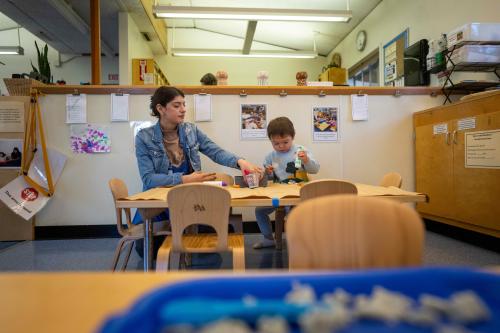Curriculum Approach
Teachers work within a flexible, inquiry-based curriculum framework to meet the needs and interests of each group and of individual children.
While participating in program, all enrolled children will:
- freely explore an appropriately stimulating, varied, and safe indoor and outdoor environment in which to play and learn;
- exercise individual choice of activities and friendships and, with adult support, learn to take responsibility for their choices;
- learn a variety of critical reasoning and problem-solving skills and increase their mastery of existing skills;
- participate in an environment in which children and adults can interact with honesty, empathy, interest, and affection;
- increase their mastery within all developmental domains, including social-emotional, linguistic, physical, and cognitive;
- build their knowledge and skills, as developmentally appropriate, in the curriculum content areas of early literacy, early mathematics, science and technology, creative expression, health and safety, and social studies, through active participation in curricular experiences based on their emerging abilities and interests;
- feel supported in self-initiated experiences that will foster their growing competence, sense of initiative, and positive dispositions toward learning;
- participate in developmentally appropriate teacher-initiated activities designed to introduce them to new information, ideas and opportunities; and
- feel supported in achieving their potential, enjoying their experiences, and participating according to their individual interests, abilities and preferences.


The ECLS continually evaluates its curriculum and makes modifications based on current research and new evidence for effective practices, while maintaining our core values and desired outcomes for children. We know that effective curriculum for all age groups is developed through a cyclical process of observation, planning, implementation, documentation, and evaluation; reflection is at its core. Families are engaged as esteemed partners, helping shape the program by sharing their values, beliefs, languages, and experiences.
Physical Environment
Designed for staff to supervise children by sight and sound
Welcoming and aesthetically pleasing
Reflective of community (e.g., use of real images, cultural artifacts, and programmatic documentation)
Clearly defined learning areas and pathways
Opportunities to develop diverse skills in all settings
Outdoor play areas are an integral part of the learning environment for all age groups
Materials, Equipment, and Experiences
- Open-ended to prompt exploration, experimentation, and discovery
- Changed over time to reflect current curriculum concepts and content
- Selected with intentionality, to promote all domains of development
- Adapted to support full inclusion
Grouping
Grouped according to developmental stage (e.g., infant, toddler, preschool)
Classroom cohorts remain together for entire school year
Scheduling
Consistent and predictable to build trust and develop temporal understanding
Balance of structured and unstructured experiences, teacher-initiated and child-initiated learning
Large blocks of time where children can work on activities of choice
Flexible; children may move at a pace that suits their individual temperament
Assessment
Use of naturalistic observation, work samples, photo documentation, anecdotal records, and learning stories to evaluate the development of the whole child; Desired Results Developmental Profile (2015)
Program Evaluation
A program is seen as successful if children progress according to physical, cognitive, and affective norms, and previously listed Desired Outcomes are achieved.
